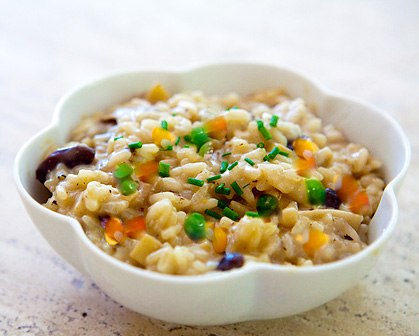For many Italians, Easter without lamb on their table is hard to imagine. The tradition of eating lamb at Pasqua, the most important religious celebration of the year, is strongly rooted in history. Agnello is an important symbol in many religions, but especially in Christianity. The image of the lamb appears in some of the most treasured Renaissance masterpieces such as Leonardo’s “Madonna and St. Anne” and the symbol of a lamb is represented in thousands of ecclesiastical images as well as secular emblems, seals and flags all over the world. The custom of eating lamb at important religious feasts goes back thousands of years, spanning many cultures and religions, especially in the regions around the Mediterranean Sea.
In Italy, the most sought-after lamb for Easter is the agnello da latte or milk-fed lamb. In the regions of Lazio and Abruzzo it is also called abbacchio, which is a four-week-old lamb exclusively nourished by its mother’s milk. At the market, these lambs usually weigh less than 20 pounds and the meat has a light pink color and an exquisite taste.
One of the most beloved preparations of lamb in Italy is costolette d’agnello or lamb chops, marinated and then grilled. The most renowned recipe for grilled lamb is Abbacchio alla Scottadito, which was originally made famous in Rome. The recipe, which means “lamb that burns the fingers,” is also prepared in many parts of central Italy such as Abruzzo, Umbria, Marche and throughout Lazio.
Agnello, particularly the cosciotto (leg) or spalla (shoulder), is also delicious baked with rosemary or marinated in lemon and then roasted. Other parts of the lamb, particularly from the forequarter, are often used in stews (spezzatini) or in ragù d’agnello (lamb meat sauces). Stewed or roasted lamb meat is also used as a filling for pasta.
For Easter, in the rural areas of central and southern Italy, it is still common to slowly roast whole lambs over an open fire or smoldering coals or in wood-burning ovens normally used for bread. When the lamb is ready, a plate of succulent meat is beautifully presented, often accompanied by roasted potatoes. Naturally, this lamb course is preceded and followed by other special dishes: antipasti, pasta, vegetables, desserts and wine.
Abbacchio alla Scottadito
Ingredients
- 8 to 12 lamb chops
- 3 fresh bay leaves, finely ground
- 3 sage leaves
- 1 sprig fresh rosemary
- a few juniper berries
- sea salt
- black peppercorns
- ½ glass dry white wine
- 6 tbsp extra virgin olive oil
- 2 lemons, cut into wedges
Preparation
Layer the lamb chops in a large container. With a mortar, a knife or an electric grinder, finely grind all of the herbs and spices, including the salt and pepper (if you use a knife, use the flat side to first crush the juniper berries, peppercorns and salt). Place the mixture in a bowl, then add the wine and olive oil, stirring with a fork. Pour this marinade into the container with the layered lamb chops. Marinate overnight.
Ideally, lamb chops are best grilled on an open coal fire or barbecue, but you can also cook them on the stove in a cast-iron grill or a heavy pan. They will be ready very quickly. Lamb chops can be served rare or medium-rare, according to your preference. Serve them hot with roasted potatoes and baby carrots.
Spring Vegetable Risotto
Ingredients
- 1 medium onion, finely chopped
- 1 small carrot, diced
- 2 tbsp unsalted butter
- 1 cup peas
- ½ cup corn
- 3/4 cup baby bella mushrooms, sliced
- 1 ½ cups Arborio rice
- pinch of saffron
- 1/4 cup dry white wine
- 4 cups chicken stock
- coarse salt and freshly ground pepper to taste
- ½ cup freshly grated Parmigiano cheese
Preparation
Heat the chicken stock in a sauce pan over a medium-high flame until hot. In a large frying pan, soften the chopped onion with the diced carrots in one tablespoon butter over a medium flame for about 4 minutes, then add the sliced baby bella mushrooms. Cook for another 3 minutes. Add the rice and cook, stirring, for 2 to 3 minutes, until the rice is well coated with butter and begins to turn opaque. Add a pinch of saffron and the dry white wine; stir thoroughly.
Add a cup of the hot chicken stock and cook, stirring, until most of the liquid is absorbed; then add another half cup of stock and continue cooking, stirring frequently.
Next, add the peas and corn, plus another cup of stock. Continue cooking and as the rice absorbs the liquid; add the additional chicken stock until the rice is al dente. The dish is done when the risotto is firm, but tender and creamy. The vegetables should be just on the slightly tender side. Season to taste with salt and pepper. Stir in the Parmigiano cheese and remaining butter and serve immediately.





